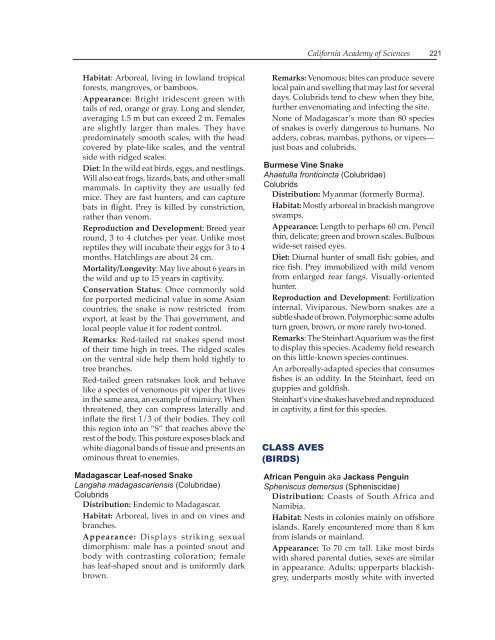THE STEINHART AQUARIUM - Gulf of Guinea Science ...
THE STEINHART AQUARIUM - Gulf of Guinea Science ...
THE STEINHART AQUARIUM - Gulf of Guinea Science ...
You also want an ePaper? Increase the reach of your titles
YUMPU automatically turns print PDFs into web optimized ePapers that Google loves.
Habitat: Arboreal, living in lowland tropical<br />
forests, mangroves, or bamboos.<br />
Appearance: Bright iridescent green with<br />
tails <strong>of</strong> red, orange or gray. Long and slender,<br />
averaging 1.5 m but can exceed 2 m. Females<br />
are slightly larger than males. They have<br />
predominately smooth scales, with the head<br />
covered by plate-like scales, and the ventral<br />
side with ridged scales.<br />
Diet: In the wild eat birds, eggs, and nestlings.<br />
Will also eat frogs, lizards, bats, and other small<br />
mammals. In captivity they are usually fed<br />
mice. They are fast hunters, and can capture<br />
bats in flight. Prey is killed by constriction,<br />
rather than venom.<br />
Reproduction and Development: Breed year<br />
round, 3 to 4 clutches per year. Unlike most<br />
reptiles they will incubate their eggs for 3 to 4<br />
months. Hatchlings are about 24 cm.<br />
Mortality/Longevity: May live about 6 years in<br />
the wild and up to 15 years in captivity.<br />
Conservation Status: Once commonly sold<br />
for purported medicinal value in some Asian<br />
countries, the snake is now restricted from<br />
export, at least by the Thai government, and<br />
local people value it for rodent control.<br />
Remarks: Red-tailed rat snakes spend most<br />
<strong>of</strong> their time high in trees. The ridged scales<br />
on the ventral side help them hold tightly to<br />
tree branches.<br />
Red-tailed green ratsnakes look and behave<br />
like a species <strong>of</strong> venomous pit viper that lives<br />
in the same area, an example <strong>of</strong> mimicry. When<br />
threatened, they can compress laterally and<br />
inflate the first 1/3 <strong>of</strong> their bodies. They coil<br />
this region into an “S” that reaches above the<br />
rest <strong>of</strong> the body. This posture exposes black and<br />
white diagonal bands <strong>of</strong> tissue and presents an<br />
ominous threat to enemies.<br />
Madagascar Leaf-nosed Snake<br />
Langaha madagascariensis (Colubridae)<br />
Colubrids<br />
Distribution: Endemic to Madagascar.<br />
Habitat: Arboreal, lives in and on vines and<br />
branches.<br />
Appearance: Displays striking sexual<br />
dimorphism: male has a pointed snout and<br />
body with contrasting coloration; female<br />
has leaf-shaped snout and is uniformly dark<br />
brown.<br />
California Academy <strong>of</strong> <strong>Science</strong>s<br />
Remarks: Venomous; bites can produce severe<br />
local pain and swelling that may last for several<br />
days. Colubrids tend to chew when they bite,<br />
further envenomating and infecting the site.<br />
None <strong>of</strong> Madagascar’s more than 80 species<br />
<strong>of</strong> snakes is overly dangerous to humans. No<br />
adders, cobras, mambas, pythons, or vipers—<br />
just boas and colubrids.<br />
Burmese Vine Snake<br />
Ahaetulla fronticincta (Colubridae)<br />
Colubrids<br />
Distribution: Myanmar (formerly Burma).<br />
Habitat: Mostly arboreal in brackish mangrove<br />
swamps.<br />
Appearance: Length to perhaps 60 cm. Pencil<br />
thin, delicate; green and brown scales. Bulbous<br />
wide-set raised eyes.<br />
Diet: Diurnal hunter <strong>of</strong> small fish: gobies, and<br />
rice fish. Prey immobilized with mild venom<br />
from enlarged rear fangs. Visually-oriented<br />
hunter.<br />
Reproduction and Development: Fertilization<br />
internal. Viviparous. Newborn snakes are a<br />
subtle shade <strong>of</strong> brown. Polymorphic: some adults<br />
turn green, brown, or more rarely two-toned.<br />
Remarks: The Steinhart Aquarium was the first<br />
to display this species. Academy field research<br />
on this little-known species continues.<br />
An arboreally-adapted species that consumes<br />
fishes is an oddity. In the Steinhart, feed on<br />
guppies and goldfish.<br />
Steinhart’s vine shakes have bred and reproduced<br />
in captivity, a first for this species.<br />
CLASS AVES<br />
(BIRDS)<br />
African Penguin aka Jackass Penguin<br />
Spheniscus demersus (Spheniscidae)<br />
Distribution: Coasts <strong>of</strong> South Africa and<br />
Namibia.<br />
Habitat: Nests in colonies mainly on <strong>of</strong>fshore<br />
islands. Rarely encountered more than 8 km<br />
from islands or mainland.<br />
Appearance: To 70 cm tall. Like most birds<br />
with shared parental duties, sexes are similar<br />
in appearance. Adults: upperparts blackishgrey,<br />
underparts mostly white with inverted<br />
221


